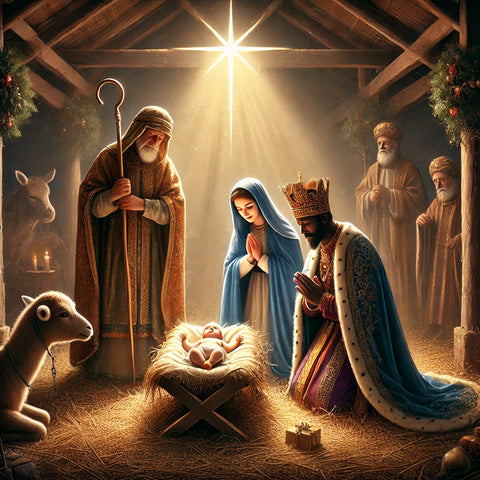The Feast of the Epiphany, celebrated annually on January 6, marks a pivotal moment in the Christian calendar: the manifestation of Jesus Christ as the Savior not just of Israel, but of the whole world. The word "Epiphany" means "revelation" or "appearance," and the feast commemorates the visit of the Magi—wise men from the East—who followed a mysterious star to find and worship the newborn King of the Jews. Their journey symbolizes the recognition of Christ by the Gentiles, a moment of profound spiritual significance for Christians worldwide.
For centuries, the story of the Magi has inspired art, music, and devotional reflections. Among the most vivid accounts of their visit comes from Blessed Anne Catherine Emmerich, a 19th-century Augustinian nun and German mystic. Despite her humble beginnings and frail health, she became renowned for her intense piety and mystical visions, which were meticulously recorded by Clemens Brentano, a German poet and writer. These works, including The Life of the Blessed Virgin Mary, provide a richly detailed and mystical perspective on the Magi’s journey and their encounter with the Holy Family. Anne Catherine Emmerich’s holiness and spiritual gifts were recognized by the Church, and she was beatified in 2004 by Pope John Paul II.
Who Were the Magi? Insights from Blessed Anne Catherine Emmerich
In her mystical visions, Blessed Anne Catherine Emmerich provided fascinating details about the Magi, shedding light on their origins, roles, and the spiritual significance of their journey. Here is an excerpt from her recorded visions, describing who the Magi were and their divine calling:
“The three kings came from widely separated regions, each guided by an inner conviction and the appearance of the miraculous star. They were men of great wisdom and high rank, deeply respected in their lands for their knowledge of the heavens and spiritual insight. Each of them ruled over a distinct territory, yet they shared a common expectation of a divine King whose birth had been foretold in their ancient prophecies.
Melchior, the eldest, came from a region with vast deserts and golden sands. He was a patriarchal figure with a long white beard and a demeanor of solemn authority. His gift of gold symbolized kingship and the recognition of the divine authority of the Christ Child.
Balthazar, a younger and more robust figure, hailed from a lush and fertile region. His skin was darker, and he wore elaborate garments adorned with intricate patterns. He brought frankincense, a symbol of divinity and worship, as an offering to the Child.
Caspar, the youngest, was of medium stature and had a ruddy complexion. His homeland was mountainous and filled with rare herbs and spices. He presented myrrh, a foreshadowing of the suffering and death that awaited the Messiah.
The three were not kings in the sense of wielding worldly power, but spiritual leaders, scholars, and seekers of truth. They were united by their profound faith and an extraordinary vision that convinced them to undertake this arduous journey. Their arrival in Bethlehem was not merely an act of homage but a recognition of the divine plan unfolding in the Christ Child.”
The Visit of the Magi: Anne Catherine Emmerich’s Vision
In her visions, Blessed Anne Catherine Emmerich provides extraordinary details about the Magi's journey, their divine inspiration, and their encounter with the Christ Child. Here is an excerpt from her recorded visions:
“I saw the three kings, Melchior, Balthazar, and Caspar, setting out on their journey with a great number of attendants. Each of them came from a different direction, but they all met at a well under a tree and joyfully joined their caravans. The star they followed was not like a natural star; it was a radiant figure of light that moved before them. At times, the star descended closer to the earth, as if inviting them onward.
When the kings arrived at the stable in Bethlehem, they dismounted from their camels and were filled with awe at the sight of the humble dwelling. The star hovered over the stable, flooding it with a brilliant light. As they entered, I saw them bow low before the Holy Family. They laid their gifts—gold, frankincense, and myrrh—before the Child Jesus, who was lying in Mary’s arms. Each king approached reverently, offering his gift with deep humility and adoration. The Blessed Virgin received them with a gentle smile and a quiet dignity that reflected her awareness of the sacredness of the moment.
After presenting their gifts, the Magi knelt in silent prayer. I could see their hearts filled with joy and gratitude, as if the journey of their entire lives had culminated in this holy encounter. They did not stay long, as they understood the need to leave the Holy Family undisturbed. When they departed, they avoided returning to Herod as they had been warned in a dream, choosing instead to take separate paths home to ensure the safety of the Child.”
Reflections on the Magi’s Journey
Blessed Anne Catherine Emmerich’s account offers a deeply spiritual interpretation of the Magi’s journey. It emphasizes their unwavering faith, humility, and devotion, as well as the divine guidance that led them to the Savior. The luminous star in her vision serves as a metaphor for the light of Christ, guiding seekers toward truth and salvation.
The gifts of the Magi—gold, frankincense, and myrrh—are imbued with symbolic meaning: gold representing Christ’s kingship, frankincense His divinity, and myrrh His future sacrifice. Emmerich’s vision reminds us that the Magi's act of worship is not just a historical event but a timeless call for all of humanity to seek, recognize, and honor Christ in their lives.
The Feast of the Epiphany invites us to meditate on the universality of Christ’s mission and the faith of those who seek Him, even from distant lands and cultures. Blessed Anne Catherine Emmerich’s vision of the Magi enriches our understanding of this sacred event, offering a glimpse into the profound reverence and joy of encountering the Word made flesh.

